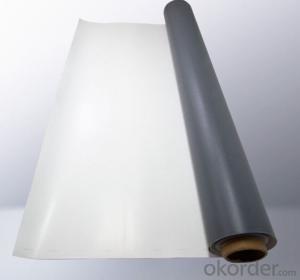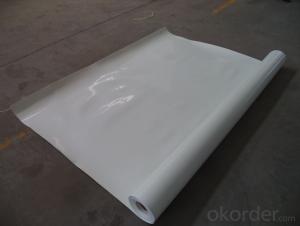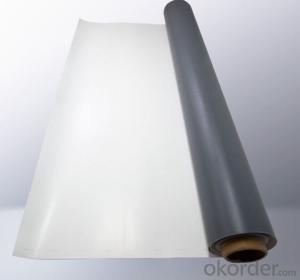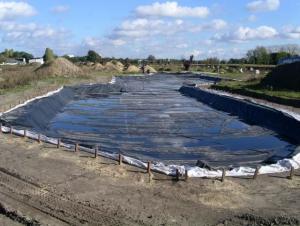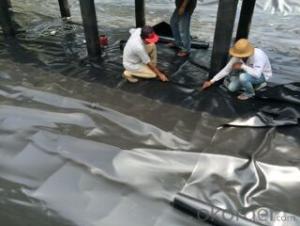TPO Waterproof Membrane for Width2.05m,Thickness 1.2mm 1.5mm 2mm
- Loading Port:
- Qingdao
- Payment Terms:
- TT or LC
- Min Order Qty:
- 1000 m²
- Supply Capability:
- 100000 m²/month
OKorder Service Pledge
OKorder Financial Service
You Might Also Like
Polyester Fleece Backing Thermoplastic Polyolefin Waterproof Membrane
Description
PMT-3020TPO is a waterproof sheet, consisting of thermoplastic polyolefin compound resin materials as the base stock, reinforced with fiber backing materials. There have two kinds of thickness: 1.2mm and 1.5mm.
Where to use
● Various roofing waterproof projects, such as industrial and civil buildings, public constructions;
● Full adhered system for concrete substrate or mechanically attached systems.
Advantages
● Weather resistance and durability;
● Excellent weld ability;
● No any crisp agents to prevent materials brittleness;
● Intermediate enhanced polyester mesh fabric to have high tensile strength, fatigue resistance and penetrating resistance suitable for
mechanically attached roofing systems;
● Excellent the same high and low temperature resistance as rubber materials which can keep flexible at -50° C and keep mechanical
strength in high temperature;
● Excellent chemical resistance to acids, bases, and restaurant exhaust emissions;
● Dimension stability;
● White-based light-color and smooth surface with high reflection, energy saving and anti-dust functions;
● Use heat welding for the seam areas to form a reliable seamless waterproof layer.
Typical properties
Item | Requirement | Test Method | ||
Thickness, min, mm | Sheet-overall | ≥1.0 | ASTM D6878 | |
Coating over fabric or scrim, weathering side only | ≥0.305 | ASTM D751 | ||
Breaking strength, min, N | ≥976 | ASTM D751 | ||
Elongation at reinforcement break, min, % | ≥15 | ASTM D751 | ||
Tensile strength,min, N | ≥245 | ASTM D751 | ||
Brittleness point, max, °C | ≤-40 | ASTM D2137 | ||
Ozone resistance | no cracks | ASTM D1149 | ||
Properties after heat aging | Breaking strength, % min | ≥90 | ASTM D573 | |
Elongation at reinforcement break, % min | ≥90 | ASTM D573 | ||
Tearing strength, % min | ≥60 | ASTM D573 | ||
Weight change (mass), max % | ≤±1 | ASTM D573 | ||
Linear dimensional change, max, % | ≤±1 | ASTM D1204 | ||
Water absorption, max, mass % | ≤±3.0 | ASTM D471 | ||
Factory seam strength, min, N | ≥290 | ASTM D751 | ||
Weather resistance | Visual inspection | - | ||
Packaging
Rolled with hard materials and packed with plastic bags or woven bags.
Thickness | Roll Size | Rolls / Pallet | Pallets / 20’ Container |
1.2 mm | 15 m2 | 25 | 20 |
20 m2 | 25 | ||
30 m2 | 25 | ||
1.5 mm | 15 m2 | 25 | |
20 m2 | 25 | ||
30 m2 | 20 |
Above quantities are indicative only. We can produce it according to your demands.
Storage
PMT-3020TPO material should be stored in well-ventilated place and avoid being exposed to the sun or rain. The temperature in stored places can not be higher than 45° C. It only can be put horizontally in five-level. It has to be avoided acid, alkali, oil and organic solvents. The shelf life is 1 year.
Transportation
PMT-3020TPO material should avoid inclination or lateral drift during transportation. When necessary, covering with felted fabric.
Application System
Yuhong not only provides TPO waterproofing membrane, but also dedicates to integrated roofing systems. Yuhong TPO single ply roofing waterproof system includes mechanically attached roofing system, fully adhered roofing system and ballasted roofing system.
Application Methods
● For Mechanically Attached Roofing System
Before application, spread TPO membranes on substrate in advance. Install TPO membranes perpendicular to steel deck ribs on the substrate without distortions according to the flange. The overlapping width is 120 mm. The minimum overlapping distance of membrane short side direction is 50 mm. Fasteners are installed according to designed position. Hot-air welding is adopted for laps with 40 mm welding width.
●For Fully Adhered Roofing System
Before application, spread TPO membranes on substrate in advance. Install TPO membranes on the substrate without distortions according to the flange. The overlapping width should be more than 50 mm. Hot-air welding is adopted for laps with 40 mm welding width. Professional adhesives need to be used on both underside and substrate surfaces to adhere and maintain.
● For Ballasted Roofing System
Before application, spread TPO membranes on substrate in advance. Install TPO membranes on the substrate without distortions according to the flange. The overlapping width should be more than 50 mm. Hot-air welding is adopted for laps with 40 mm welding width.
Attentions
● TPO membranes reflect heat and light, wearing protective clothing (long-sleeved shirt, long-barreled trousers), and wearing a filter to protect the skin and eyes from UV-induced damage.
● Security measures for roof perimeter are necessary when application. Sheet surface is slippery when wet, taking care to avoid slide.
● Sealants and adhesives are flammable containing solvents. They will be dangerous when exposure to heat, even have the possibility to catch fire and explode.
● Sealants, adhesives, cleaners should be avoided contacting with skin and eyes.
● No smoking during application.
Images of TPO Rubber Waterproof Membrane:
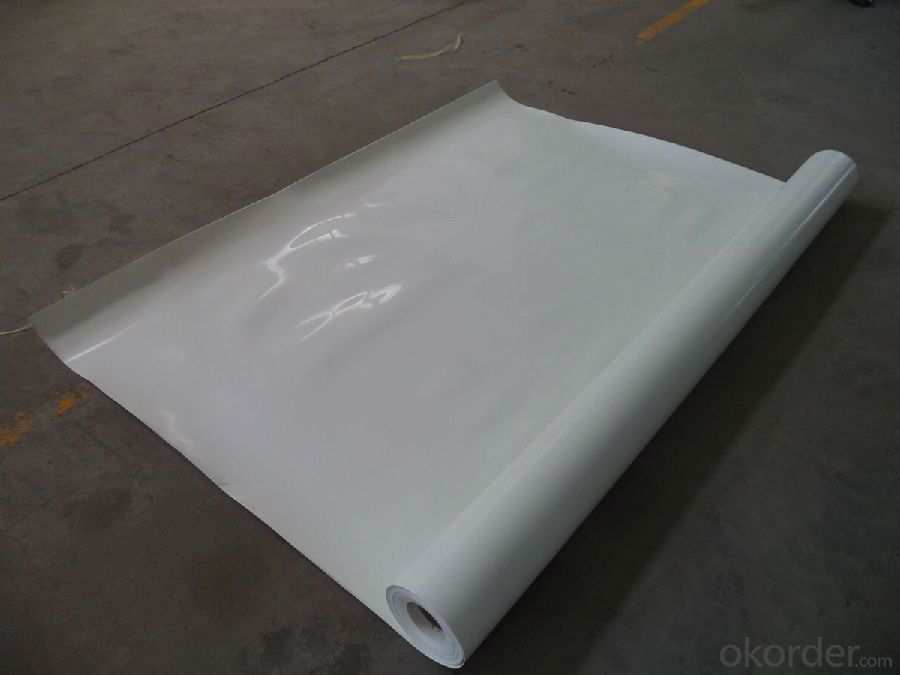
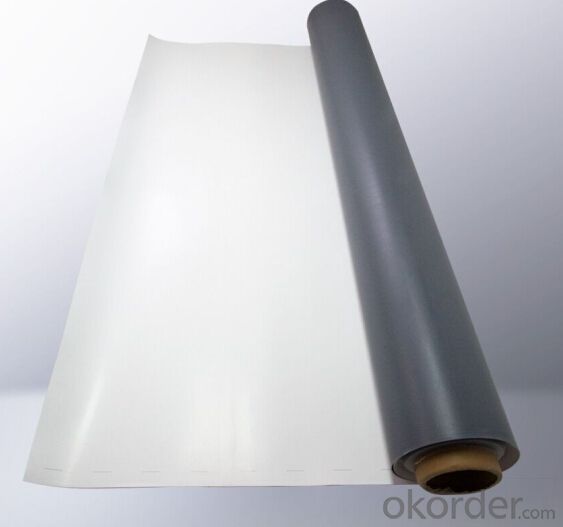
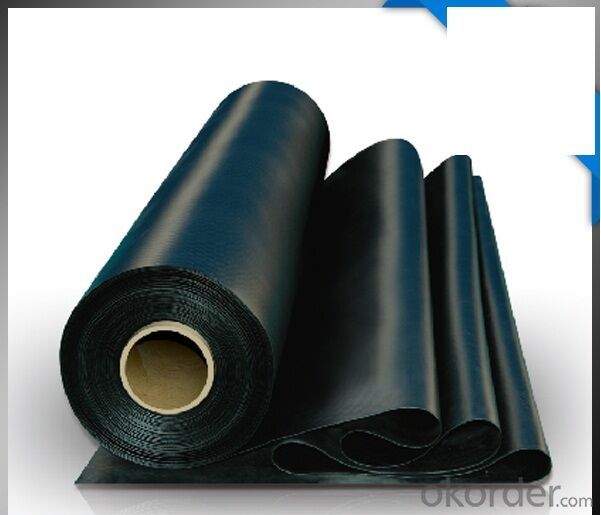
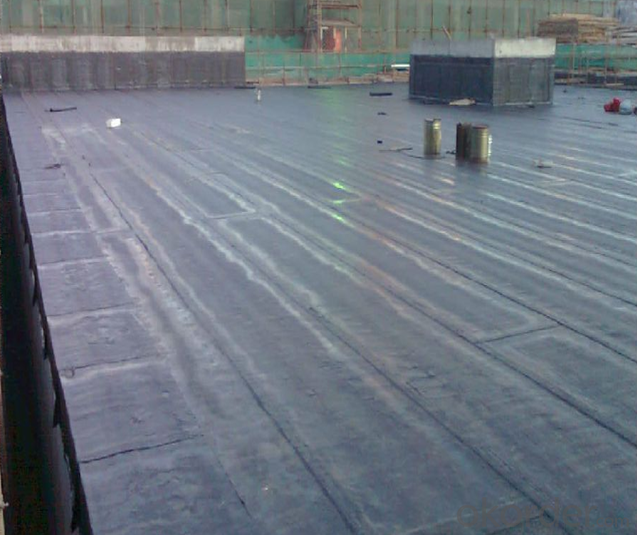
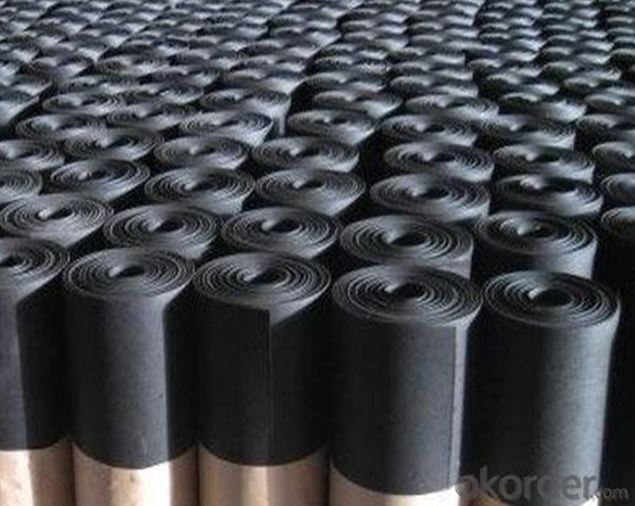
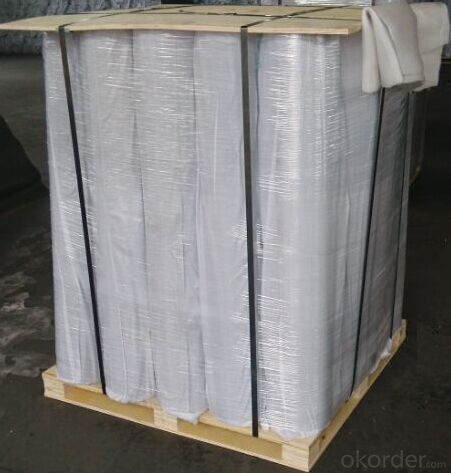
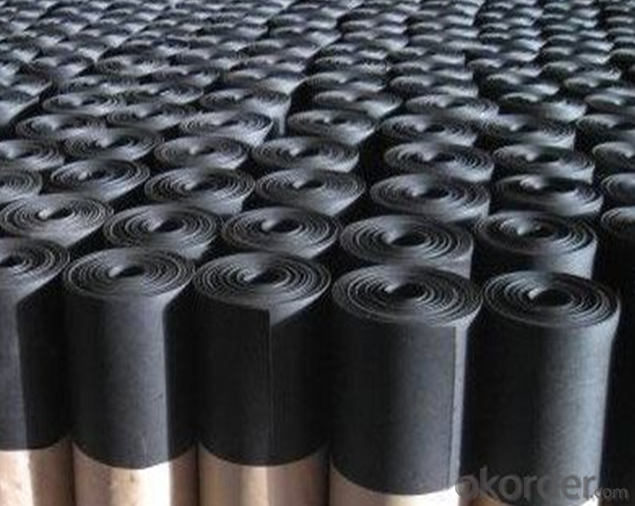
FAQ:
1. What are we supplying?
We are specialized in producing Colorful Asphalt Roof Shingle, SBS/APP modified bitumen waterproof membrane, Self adhesive bitumen waterproof membrane, PVC waterproofing membrane, EPDM rubber roofing membrane, Single Component Polyurethane Waterproof Coating, and Spray Polyurea Waterproof Coating
.
2. How Many years experience do we have?
We have been exported to more than 20 countries in the past 15 years.
3. How long do we usually reply your request?
We always reply our customer within 24 hours.
- Q:What is BSB waterproofing membrane
- ?Features: The coil has excellent high temperature resistance and can be used at -25 in the temperature range of + 100 ° C, with high elasticity and fatigue resistance, as well as up to 1500% elongation and strong puncture resistance , Tear-resistant cold. Suitable for cold areas, as well as deformation and vibration of large industrial and civil buildings waterproofing works. Low temperature flexibility is good, to -25 ℃ does not crack; high heat resistance 100 ℃ does not flow. Good extension performance, long service life, simple construction, small pollution and so on.
- Q:Can a waterproofing membrane be used on precast concrete block surfaces?
- Yes, a waterproofing membrane can be used on precast concrete block surfaces. Waterproofing membranes are commonly used to protect below-grade structures, such as basements and foundations, from water intrusion. Precast concrete blocks are commonly used in the construction of these structures, and applying a waterproofing membrane can help prevent water from penetrating through the concrete and causing damage. The membrane acts as a barrier, preventing the passage of water while still allowing the concrete to breathe and release any moisture buildup. Additionally, waterproofing membranes can also help improve the overall durability and longevity of the precast concrete blocks by protecting them from moisture-related issues such as cracking, spalling, and corrosion. It is important to choose a waterproofing membrane that is specifically designed for below-grade applications and is compatible with concrete surfaces to ensure proper adhesion and long-term effectiveness.
- Q:How does a waterproofing membrane handle structural cracks?
- A waterproofing membrane is designed to handle structural cracks by providing a barrier that prevents water from penetrating the cracks and causing damage to the underlying structure. The membrane is typically applied to the surface of a structure and acts as a protective layer that seals the cracks, preventing water infiltration. When a structural crack occurs, the waterproofing membrane is able to bridge the gap and create a waterproof seal. This is achieved through the use of flexible materials that can stretch and move with the structure, accommodating any movements or shifts that may occur over time. The membrane is also able to adhere to a variety of surfaces, ensuring a tight and secure bond that prevents water from seeping through the cracks. Additionally, some waterproofing membranes have the ability to self-heal. This means that if a crack does occur, the membrane has the ability to repair itself, closing the gap and maintaining its waterproofing capabilities. Overall, a waterproofing membrane is an effective solution for handling structural cracks as it provides a durable and flexible barrier that prevents water intrusion and protects the integrity of the structure. It is important to choose the appropriate type of membrane for the specific structural requirements and to ensure proper installation to achieve the desired waterproofing results.
- Q:Can a waterproofing membrane be applied on any surface?
- No, a waterproofing membrane cannot be applied on any surface. It is important to assess the suitability of the surface before applying a waterproofing membrane. The surface should be clean, structurally sound, and free from any contaminants that could hinder the adhesion of the membrane. Additionally, certain surfaces may require specific preparation or priming before the membrane can be applied effectively.
- Q:Can a waterproofing membrane be used for military facilities?
- Yes, a waterproofing membrane can be used for military facilities. Waterproofing membranes are commonly used to protect structures from water infiltration and damage, which is crucial in military facilities to ensure the integrity and longevity of the infrastructure. Additionally, waterproofing membranes can also provide additional benefits such as protection against chemical and environmental hazards, making them suitable for military applications.
- Q:Can a waterproofing membrane be used for parking garages?
- Yes, a waterproofing membrane can be used for parking garages. Waterproofing membranes are commonly used in construction to prevent water infiltration and damage to structures. Given the potential exposure of parking garages to water from rainfall, snowmelt, or vehicle fluids, using a waterproofing membrane can help protect the structural integrity of the garage and extend its lifespan.
- Q:Can a waterproofing membrane be used in schools or educational buildings?
- Yes, a waterproofing membrane can definitely be used in schools or educational buildings. Waterproofing membranes are designed to prevent water penetration and protect the building structure from moisture damage. In educational buildings, where a large number of students and staff gather, it is crucial to maintain a safe and healthy environment. Waterproofing membranes can be used in various areas such as basements, roofs, walls, and foundations to prevent water leakage, dampness, and mold growth. By installing a waterproofing membrane, schools can ensure the longevity of their buildings, protect valuable equipment and resources, and provide a comfortable learning environment for students and staff.
- Q:Can a waterproofing membrane be used on roofs with solar panels?
- Roofs with solar panels can indeed incorporate a waterproofing membrane. In fact, it is strongly advised to utilize a waterproofing membrane in these instances to guarantee the roof's integrity and fend off any potential leaks. The waterproofing membrane serves as a shield, preventing water infiltration into the roof structure and averting any harm. It is crucial to select a waterproofing membrane that harmonizes with the solar panels and does not impede their efficacy. Furthermore, proper installation methods must be adhered to in order to seamlessly integrate the membrane and solar panels.
- Q:What is the cost of a waterproofing membrane installation?
- The cost of a waterproofing membrane installation can vary depending on various factors such as the size and complexity of the area to be waterproofed, the type of membrane being used, and the location of the project. Generally, the cost can range from $3 to $10 per square foot. For a basic installation, which typically involves applying a liquid or roll-on membrane, the cost can be on the lower end of the spectrum. However, if the project requires additional preparation work such as repairing cracks or uneven surfaces, the cost may increase. Moreover, the type of membrane being used can also impact the cost. There are different types of waterproofing membranes available, including bituminous membranes, thermoplastic membranes, and elastomeric membranes. Each type has its own advantages and disadvantages, and the cost can vary accordingly. Additionally, the location of the project can influence the cost. Labor and material prices may vary depending on the region or city, and contractors may also consider transportation costs if the project is in a remote area. It is important to obtain multiple quotes from reputable contractors to determine the specific cost for your waterproofing membrane installation. Consulting with professionals and discussing your specific requirements will help you get an accurate estimate for your project.
- Q:Can a waterproofing membrane be used in swimming pools or other water features?
- Certainly, swimming pools or other water features can indeed utilize a waterproofing membrane. In fact, it is highly advisable to employ such a membrane in these areas to avert water leakage and potential harm. By serving as a barrier between the water and the surrounding structures, a waterproofing membrane ensures that the water remains contained within the pool or water feature. Not only does it prevent water seepage, which can inflict structural damage and necessitate expensive repairs, but it also safeguards the pool or water feature from the harsh chemicals employed for water treatment, thereby guaranteeing its durability and long lifespan. Consequently, the utilization of a waterproofing membrane is an essential measure in the construction or renovation of swimming pools or other water features, guaranteeing their functionality and longevity.
1. Manufacturer Overview |
|
|---|---|
| Location | |
| Year Established | |
| Annual Output Value | |
| Main Markets | |
| Company Certifications | |
2. Manufacturer Certificates |
|
|---|---|
| a) Certification Name | |
| Range | |
| Reference | |
| Validity Period | |
3. Manufacturer Capability |
|
|---|---|
| a)Trade Capacity | |
| Nearest Port | |
| Export Percentage | |
| No.of Employees in Trade Department | |
| Language Spoken: | |
| b)Factory Information | |
| Factory Size: | |
| No. of Production Lines | |
| Contract Manufacturing | |
| Product Price Range | |
Send your message to us
TPO Waterproof Membrane for Width2.05m,Thickness 1.2mm 1.5mm 2mm
- Loading Port:
- Qingdao
- Payment Terms:
- TT or LC
- Min Order Qty:
- 1000 m²
- Supply Capability:
- 100000 m²/month
OKorder Service Pledge
OKorder Financial Service
Similar products
New products
Hot products
Related keywords

